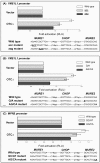Discovery of genes activated by the mitochondrial unfolded protein response (mtUPR) and cognate promoter elements
- PMID: 17849004
- PMCID: PMC1964532
- DOI: 10.1371/journal.pone.0000874
Discovery of genes activated by the mitochondrial unfolded protein response (mtUPR) and cognate promoter elements
Abstract
In an accompanying paper, we show that the mitochondrial Unfolded Protein Response or mtUPR is initiated by the activation of transcription of chop through an AP-1 element in the chop promoter. Further, we show that the c/ebp beta gene is similarly activated and CHOP and C/EBP beta subsequently hetero-dimerise to activate transcription of mtUPR responsive genes. Here, we report the discovery of six additional mtUPR responsive genes. We found that these genes encoding mitochondrial proteases YME1L1 and MPP beta, import component Tim17A and enzymes NDUFB2, endonuclease G and thioredoxin 2, all contain a CHOP element in their promoters. In contrast, genes encoding mitochondrial proteins Afg3L2, Paraplegin, Lon and SAM 50, which do not have a CHOP element, were not up-regulated. Conversely, genes with CHOP elements encoding cytosolic proteins were not induced by the accumulation of unfolded proteins in mitochondria. These results indicate that mtUPR responsive genes appear to share a requirement for a CHOP element, but that this is not sufficient for the regulation of the mtUPR. A more detailed analysis of promoters of mtUPR responsive genes revealed at least two additional highly conserved, putative regulatory sites either side of the CHOP element, one a motif of 12 bp which lies 14 bp upstream of the CHOP site and another 9 bp element, 2 bp downstream of the CHOP site. Both of these additional elements are conserved in the promoters of 9 of the ten mtUPR responsive genes we have identified so far, the exception being the Cpn60/10 bidirectional promoter. Mutation of each of these elements substantially reduced the mtUPR responsiveness of the promoters suggesting that these elements coordinately regulate mtUPR.
Conflict of interest statement
Figures





Similar articles
-
The chop gene contains an element for the positive regulation of the mitochondrial unfolded protein response.PLoS One. 2007 Sep 12;2(9):e835. doi: 10.1371/journal.pone.0000835. PLoS One. 2007. PMID: 17848986 Free PMC article.
-
Regulation of aldehyde reductase expression by STAF and CHOP.Genomics. 2004 Jan;83(1):119-29. doi: 10.1016/s0888-7543(03)00213-1. Genomics. 2004. PMID: 14667815
-
Molecular cloning and characterization of the cyclic AMP-responsive ovine CYP11A1 (cholesterol side-chain cleavage) gene promoter: DNase 1 protection of conserved consensus elements.J Mol Endocrinol. 1993 Jun;10(3):297-311. doi: 10.1677/jme.0.0100297. J Mol Endocrinol. 1993. PMID: 8373514
-
A New Vision of Mitochondrial Unfolded Protein Response to the Sirtuin Family.Curr Neuropharmacol. 2020;18(7):613-623. doi: 10.2174/1570159X18666200123165002. Curr Neuropharmacol. 2020. PMID: 31976838 Free PMC article. Review.
-
Regulation of the human thioredoxin gene promoter and its key substrates: a study of functional and putative regulatory elements.Biochim Biophys Acta. 2014 Jan;1840(1):303-14. doi: 10.1016/j.bbagen.2013.09.013. Epub 2013 Sep 13. Biochim Biophys Acta. 2014. PMID: 24041992 Review.
Cited by
-
Redox regulation of UPR signalling and mitochondrial ER contact sites.Cell Mol Life Sci. 2024 Jun 7;81(1):250. doi: 10.1007/s00018-024-05286-0. Cell Mol Life Sci. 2024. PMID: 38847861 Free PMC article. Review.
-
Mitochondrial perturbation in immune cells enhances cell-mediated innate immunity in Drosophila.BMC Biol. 2024 Mar 13;22(1):60. doi: 10.1186/s12915-024-01858-5. BMC Biol. 2024. PMID: 38475850 Free PMC article.
-
Aberrant mitochondrial aggregation of TDP-43 activated mitochondrial unfolded protein response and contributed to recovery of acetaminophen induced acute liver injury.Toxicol Res (Camb). 2024 Jan 25;13(1):tfae008. doi: 10.1093/toxres/tfae008. eCollection 2024 Feb. Toxicol Res (Camb). 2024. PMID: 38283824
-
Mammalian integrated stress responses in stressed organelles and their functions.Acta Pharmacol Sin. 2024 Jun;45(6):1095-1114. doi: 10.1038/s41401-023-01225-0. Epub 2024 Jan 24. Acta Pharmacol Sin. 2024. PMID: 38267546 Review.
-
Mitochondrial Quality Control via Mitochondrial Unfolded Protein Response (mtUPR) in Ageing and Neurodegenerative Diseases.Biomolecules. 2023 Dec 13;13(12):1789. doi: 10.3390/biom13121789. Biomolecules. 2023. PMID: 38136659 Free PMC article. Review.
References
-
- Lindquist S. The heat-shock response. Annu Rev Biochem. 1986;55:1151–1191. - PubMed
-
- Gething MJ, Sambrook J. Protein folding in the cell. Nature. 1992;355:33–45. - PubMed
-
- Schroder M. The unfolded protein response. Mol Biotechnol. 2006;34:279–90. - PubMed
-
- Yoshida H, Matsui T, Yamamoto A, Okada T, Mori K. XBP1 mRNA is induced by ATF6 and spliced by IRE1 in response to ER stress to produce a highly active transcription factor. Cell. 2001;107:881–91. - PubMed
-
- Harding HP, Zhang Y, Bertolotti A, Zeng H, Ron D. Perk is essential for translational regulation and cell survival during the unfolded protein response. Mol Cell. 2000;5:897–904. - PubMed
Publication types
MeSH terms
Substances
LinkOut - more resources
Full Text Sources
Research Materials

